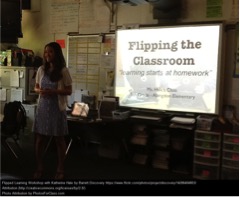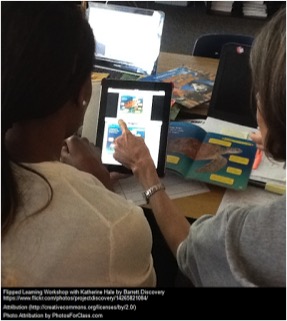Are You Flippin’ Kidding Me?
Why Would I Flip?
@joe_edtech & @LisaBerghoff
This article is co-written and cross posted by Joe & Lisa. You can also find it on Joe’s Blog: WarriorEdTech
It isn’t about using technology because it is flashy, and it definitely isn’t about more industrial age efficiency. Integrating instructional technology is about being able to do something that you’ve never been able to do before. It is about re-imagining the classroom, and everything else about school.
Last Saturday, we had an opportunity to host a Google Education On Air Hangout on the “Flipped Classroom” during which we provided our participants with a description and history of the Flipped Classroom teaching model, clear reasons why each of us tried it with our students, and some evidence of it’s effectiveness. If you are interested in reading more about that as well as accessing some tools to help you get started, you are welcome to visit the “Flipped Classroom Resources” webpage we created.
However, we don’t want to take up our blog space and inundate our loyal readers (a.k.a. – Joe’s Mom) with a lot of information about what and how. We think it is really important to start with why. Why would you take the time to flip your class? Probably the best way to explain it is through the eyes of a few students. First, we want you to see class through the eyes of Lisa’s Special Ed US History students.
My US History students all have IEPs. Reading and writing is challenging for them and US History is dense with written information. Our textbook, while adapted for reluctant readers, is very long and intimidating. I wanted my students to be able to access the information but then do something with that information. I wanted them to apply their learning, make connections and predictions for the future based on what they are learning about the past. I wanted them to participate in activities that require them to think critically, make a claim, and support it with evidence. However, most of our class time was being used to read the material, talk about the content, and reach for a basic level of understanding. I was assigning homework activities that required them to extend their learning but I quickly became frustrated because many of my students were not completing the homework. The students who were completing it often missed the mark and the quality was nowhere near what I thought they could do.
I decided to take a risk and assign a video for homework. The students would watch the video to get the information and then we could use our class time to work in small groups to apply what they learned. I was amazed when all of my students watched the 5 minute video. I gave them a short survey and the feedback was overwhelmingly positive. Watching a video for homework was a low-stakes activity. Everyone could access the video and it was much easier for them to get the information in this manner. I was so encouraged I tried several other approaches. For one assignment, I read the lesson from the text and recorded myself while highlighting the important information. I then took it one step further and created a Zaption “tour” with this video by embedding questions. I could check the analytics to see who had watched the video and their answers were recorded and even graded for me! I could see how long the students spent on the videos. One student clearly forwarded the video and just answered the questions. Another student watched it more than once. This was exactly the kind of differentiation I was looking for. The students had some control, everyone was able to get what they needed, and our class time was spent doing the kinds of activities that push their thinking and maintain the high standards that I have for my students.
@joe_edtech:
That’s the success story. On the flip side – pun intended – my daughter spends hours and hours struggling with her math homework. It is no fun, and I fear that the constant frustration will lead her to dislike math, or worse, school. When she is in class, the teacher explains the concepts and the skills, and it all makes perfect sense. But by the time she gets home, she has forgotten much of the teacher’s instruction. It is just one of many classes and activities she participates in every day. More than once Katherine has said, “Ugh, I just wish I could see her work this problem again.” And that kind of thinking shouldn’t surprise us. She is used to looking up instruction on YouTube. When she wants to learn how to fix her hair a certain way, or create something new with her Rainbow Loom, or generate ideas for building in Mine Craft, she turns FIRST to YouTube and other digital resources available to her. Imagine how empowered she would be if she could review her math, or science, or music lessons in the same way.
From a Technology Director’s perspective, I love the Flipped Classroom idea because it can act as a “Gateway Drug” to the integration of much more instructional technology, and can help facilitate the shift from teaching-centered classrooms to learning-centered classrooms. And as Lisa mentioned before, you don’t have to invest hundreds of hours to try it. All you have to do is “Flip” one lesson, one time.
You can still be a part of the conversation. Our Google Hangout Webinar “Flipped & Blended Learning for the Chromebook Classroom” is embedded below. If you have any questions, please contact us via Twitter or leave a comment in the box below.

